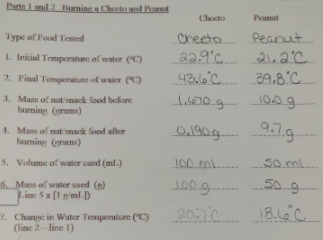Parts 1 and 2 Burning a Checto and Peanut Checto Peanut Peanut Cheeto 22.9°C Typc of Food Tested 1. Initial Temperature of water (C) 2. Final Temperature of waier (C) 43.66°C 39.8 C 3. Mass of ut/snack food before burning (grams) 10.0g- Ou190g. 9.7g- 4. Mass of nut/snack food after burning (prams) 5. Volume of water used (mL) 100ml.. 5o ml.. 6. Mass of water used (g) Line 5 x [1 g/mlL) 0g. 50g 7. Change in Water Temperature (C) (line 2-line 1) 207C 18.6°C 8. Total calories released (1 cal/g °C) x (line 6) x (line 7) 9. Total kilocalories (Food Calories) released (Line 8/ 1000) 10. Food Calories (kcal) per gram of food (Line 9/ (Line 4-Line 3))
Parts 1 and 2 Burning a Checto and Peanut Checto Peanut Peanut Cheeto 22.9°C Typc of Food Tested 1. Initial Temperature of water (C) 2. Final Temperature of waier (C) 43.66°C 39.8 C 3. Mass of ut/snack food before burning (grams) 10.0g- Ou190g. 9.7g- 4. Mass of nut/snack food after burning (prams) 5. Volume of water used (mL) 100ml.. 5o ml.. 6. Mass of water used (g) Line 5 x [1 g/mlL) 0g. 50g 7. Change in Water Temperature (C) (line 2-line 1) 207C 18.6°C 8. Total calories released (1 cal/g °C) x (line 6) x (line 7) 9. Total kilocalories (Food Calories) released (Line 8/ 1000) 10. Food Calories (kcal) per gram of food (Line 9/ (Line 4-Line 3))
Chemistry
10th Edition
ISBN:9781305957404
Author:Steven S. Zumdahl, Susan A. Zumdahl, Donald J. DeCoste
Publisher:Steven S. Zumdahl, Susan A. Zumdahl, Donald J. DeCoste
Chapter1: Chemical Foundations
Section: Chapter Questions
Problem 1RQ: Define and explain the differences between the following terms. a. law and theory b. theory and...
Related questions
Question
8.
9.
10.
![ps://cptc.instructure.com/files/188364733/download?download_frd%3D1&verifier%3DeE8mmTudmvD6CUNikRC
Page
3
of 4
Parts 1 and 2 Burning a Checto and Peanut
Checto
Peanut
Peanut
22.9°C. 21e 2C..
43.6°C 39.8°C
L670.g. 10.0 g
Typc of Food Tested
Cheeto.
1. Initial Temperature of water (C)
2. Final Teuperature of waier (C)
3. Mass of nut/snack food before
burning (grams)
Ou190g. 4.7.g.
4. Mass of nut/snack food after
burning (grams)
5. Volume of water used (mL)
100ml.
so ml..
6. Mass of water used (g)
Line 5 x [1 g/ml])
50.g-
7. Change in Water Temperature ("C)
(line 2- line 1)
20.7C 18.6éc
8. Total calories released
(1 cal/g °C) x (line 6) x (line 7)
9. Total kilocalories (Food Calories)
released
(Line 8/ 1000)
10. Food Calories (kcal) per gram of food
(Line 9/ (Line 4Line 3))
Discussion Poinis:
Compare the calories/gram of food that you obiained to known values.
Checto: 150 kcal/ 28g 5.4 kcal/g
Peanut: 567 kcal/ 100.g 5.67 kcal/g
What sources of error exist ihat may change these numbers?](/v2/_next/image?url=https%3A%2F%2Fcontent.bartleby.com%2Fqna-images%2Fquestion%2F7d53e807-f533-4850-a334-28d51d738df1%2F098df655-b9e0-4a27-91c3-dcceb682ee97%2Ft4cmzef_processed.jpeg&w=3840&q=75)
Transcribed Image Text:ps://cptc.instructure.com/files/188364733/download?download_frd%3D1&verifier%3DeE8mmTudmvD6CUNikRC
Page
3
of 4
Parts 1 and 2 Burning a Checto and Peanut
Checto
Peanut
Peanut
22.9°C. 21e 2C..
43.6°C 39.8°C
L670.g. 10.0 g
Typc of Food Tested
Cheeto.
1. Initial Temperature of water (C)
2. Final Teuperature of waier (C)
3. Mass of nut/snack food before
burning (grams)
Ou190g. 4.7.g.
4. Mass of nut/snack food after
burning (grams)
5. Volume of water used (mL)
100ml.
so ml..
6. Mass of water used (g)
Line 5 x [1 g/ml])
50.g-
7. Change in Water Temperature ("C)
(line 2- line 1)
20.7C 18.6éc
8. Total calories released
(1 cal/g °C) x (line 6) x (line 7)
9. Total kilocalories (Food Calories)
released
(Line 8/ 1000)
10. Food Calories (kcal) per gram of food
(Line 9/ (Line 4Line 3))
Discussion Poinis:
Compare the calories/gram of food that you obiained to known values.
Checto: 150 kcal/ 28g 5.4 kcal/g
Peanut: 567 kcal/ 100.g 5.67 kcal/g
What sources of error exist ihat may change these numbers?
Expert Solution
Step 1
The experiment data given is,

Trending now
This is a popular solution!
Step by step
Solved in 3 steps with 1 images

Knowledge Booster
Learn more about
Need a deep-dive on the concept behind this application? Look no further. Learn more about this topic, chemistry and related others by exploring similar questions and additional content below.Recommended textbooks for you

Chemistry
Chemistry
ISBN:
9781305957404
Author:
Steven S. Zumdahl, Susan A. Zumdahl, Donald J. DeCoste
Publisher:
Cengage Learning

Chemistry
Chemistry
ISBN:
9781259911156
Author:
Raymond Chang Dr., Jason Overby Professor
Publisher:
McGraw-Hill Education

Principles of Instrumental Analysis
Chemistry
ISBN:
9781305577213
Author:
Douglas A. Skoog, F. James Holler, Stanley R. Crouch
Publisher:
Cengage Learning

Chemistry
Chemistry
ISBN:
9781305957404
Author:
Steven S. Zumdahl, Susan A. Zumdahl, Donald J. DeCoste
Publisher:
Cengage Learning

Chemistry
Chemistry
ISBN:
9781259911156
Author:
Raymond Chang Dr., Jason Overby Professor
Publisher:
McGraw-Hill Education

Principles of Instrumental Analysis
Chemistry
ISBN:
9781305577213
Author:
Douglas A. Skoog, F. James Holler, Stanley R. Crouch
Publisher:
Cengage Learning

Organic Chemistry
Chemistry
ISBN:
9780078021558
Author:
Janice Gorzynski Smith Dr.
Publisher:
McGraw-Hill Education

Chemistry: Principles and Reactions
Chemistry
ISBN:
9781305079373
Author:
William L. Masterton, Cecile N. Hurley
Publisher:
Cengage Learning

Elementary Principles of Chemical Processes, Bind…
Chemistry
ISBN:
9781118431221
Author:
Richard M. Felder, Ronald W. Rousseau, Lisa G. Bullard
Publisher:
WILEY